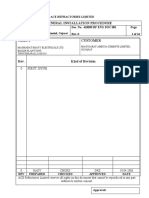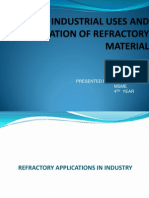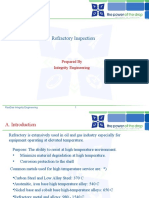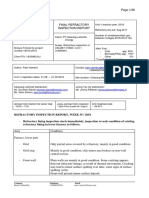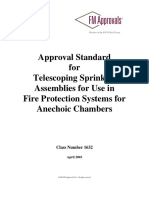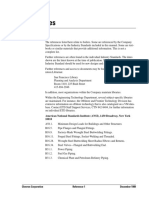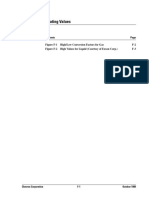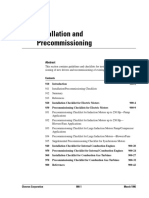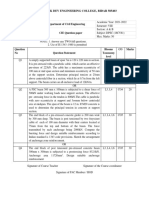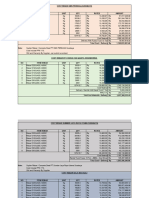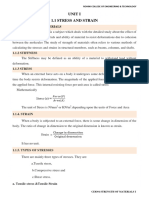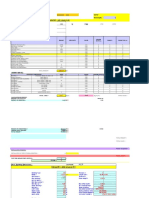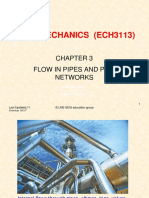IRM2900 Refractory Inspection
IRM2900 Refractory Inspection
Uploaded by
mika cabelloCopyright:
Available Formats
IRM2900 Refractory Inspection
IRM2900 Refractory Inspection
Uploaded by
mika cabelloCopyright
Available Formats
Share this document
Did you find this document useful?
Is this content inappropriate?
Copyright:
Available Formats
IRM2900 Refractory Inspection
IRM2900 Refractory Inspection
Uploaded by
mika cabelloCopyright:
Available Formats
2900 Refractory Inspection
Abstract
This section discusses inspection of newly installed refractory linings, including
repair work. The discussion includes: use of third party inspectors and testing
services; prequalification testing of materials, including the kinds of tests that are
usually performed on various refractory material; and prequalification of contrac-
tors' procedures and work crews. Specific guidelines are given for inspecting the
application of monolithic lining systems, refractory ceramic fiber systems, and
brick and special shapes. For help in evaluating existing linings for possible tear-
out, see Section 2800.
Contents Page
2910 Introduction, Background and Scope 2900-3
2920 Third-Party Inspection and Testing 2900-3
2921 Selection of a Company
2922 Duties of Third-party Company
2930 Prequalification Testing 2900-4
2931 Material Prequalification
2932 Refractory Contractor Prequalification
2933 Time Allowance for Prequalification Testing
2940 Installation Inspection of Monolithics 2900-13
2941 Material Storage and Handling
2942 Tear-out
2943 Surface Preparation
2944 Anchor Inspection
2945 Forming (Casting and Cast Vibrating)
2946 Inspection of Work Area
2947 Installation of Monolithics
2948 Preparing Production Test Samples
2950 Inspection of RCF 2900-18
Chevron Corporation 2900-1 April 1992
2900 Refractory Inspection Insulation and Refractory Manual
2951 Tear-out
2952 Surface Preparation
2953 Anchor Layout and Installation
2954 Vapor Barrier
2955 Installation of RCF
2960 Inspection of Brick and Shapes 2900-22
2961 Tear-out
2962 Surface Preparation
2963 Installation of Brick and Shapes
2970 Refractory Inspection Checklist 2900-23
April 1992 2900-2 Chevron Corporation
Insulation and Refractory Manual 2900 Refractory Inspection
2910 Introduction, Background and Scope
Inspection of refractory systems requires a combination of activities all leading to
the approval of a refractory lining. Many types of refractory products and installa-
tion methods are used in refineries and chemical plants, but all programs to ensure a
quality installation will have 3 elements:
• Material prequalification (certification),
• Contractor and crew qualification, and
• Installation inspection.
The emphasis placed on each element will depend on the scope of work and nature
of the application (i.e., for IFB applications, certifying the refractory material will
need less emphasis than crew or contractor prequalification, which will need less
than the actual installation inspection. Monolithic refractory applications will
emphasize all three elements).
A good inspection program must set hold points and acceptance/rejection criteria.
Such a program allows the inspector to perform his job and gives the contractor
firm guidelines to follow.
2920 Third-Party Inspection and Testing
The use of a third party to inspect and test refractory materials and application
methods has become a significant factor in a successful refractory installation. This
practice has resulted from increased emphasis on quality refractory work and
material.
Several companies specialize in the testing and inspection of refractories and their
application. In early 1992, the Company entered into a refractory inspection part-
nering alliance with the R. J. Jenkins Company of Webster, TX. A more detailed
description of the alliance contract and how to initiate it are described in Section
4100, Contracting Plans.
The refractory inspection partnering alliance with Jenkins Company should be
considered wherever third party refractory inspection is needed. The Company can
benefit from strong contributions to unit reliability from the Jenkins team.
These companies provide quality control programs that ensure the Company that
everything has been performed in a professional manner and is consistent with the
appropriate Company specification. Testing is either witnessed by experienced tech-
nicians or is performed in the third-party laboratory. Sometimes a mobile lab is
brought to the installation site to facilitate prequalification of the crew and to test
production samples.
Inspectors typically are experienced installers that watch the refractory installa-
tions. Generally it is important to witness the installation process, since inspection
afterward is not sufficient to determine the quality of a lining.
Independent or third-party inspection and testing is a good way to supplement the
Company's inspection capabilities. The Company's inspection force is not generally
Chevron Corporation 2900-3 April 1992
2900 Refractory Inspection Insulation and Refractory Manual
experienced in refractory work. Two areas in which it has little experience are
1) marking areas of refractory to be torn out and 2) inspecting refractory installa-
tion. Third-party inspection companies use inspectors who specialize in refractory
installation and have experience from numerous applications.
2921 Selection of a Company
Any company considered to perform inspection and testing associated with refrac-
tory applications should be examined very closely. Guidelines for selection of these
companies should include:
1. Standard pricing for testing and inspection services
2. Project experience (look at a project listing for the past 3 years)
3. Experience of inspection personnel (check resumes)
4. Standard lab practices
5. Inspection of laboratory facilities (visit the lab, when possible)
6. Outline of inspection and testing plan for individual projects
Currently, no formal requirements exist for qualifying inspectors nor are there
schools designed to help with inspection of refractory applications. Therefore, it is
important to screen the potential inspection force and request certain persons.
Proper testing of refractory products is also very important, and each independent
lab should be reviewed. A good way to review a company's credentials is to
examine its lab practices and talk to other oil companies about their experience.
Consult with the Materials Division refractories specialist for help in this area.
2922 Duties of Third-party Company
The function of any third-party inspection and testing company should be to supple-
ment the inspection efforts of the Company. This will take on different meanings
for each job and may include inspection of existing lining for potential repairs,
monitoring tear-out, monitoring anchor and refractory placement, and monitoring
dryout.
In all cases the third party is acting as a consultant and is not authorized to make
engineering decisions on behalf of the Company. They are to observe, report and
advise the Company so that sound engineering decisions can be made.
2930 Prequalification Testing
Prequalification testing includes testing the refractory material (certification),
approving the contractor's written procedures, and testing members of the installa-
tion crew. The methods for administering these tests are given in the Company's
purchase and installation specifications for refractory systems. Those in charge of
April 1992 2900-4 Chevron Corporation
Insulation and Refractory Manual 2900 Refractory Inspection
scheduling an installation job must allow time for each stage of testing (and
retesting, if needed).
2931 Material Prequalification
Material prequalification is the process of certifying a refractory product. For mono-
lithic refractory material this process is needed to ensure that the material has the
required properties specified on Standard Drawing GB-N1268. All products can
and should receive some form of certification. The degree of prequalification
depends on the type of product and variables of the manufacturing process. It also
depends on the nature of the application and assessment of the failure risk. The
project engineer may elect to amend the extent of prequalification.
Types of Tests
Figure 2900-1 shows the types of qualification tests associated with the different
product groups. Not all tests are performed for each and every purchase of refrac-
tory. The Company's refractory purchase specification IRM-MS-4785 provides
minimum testing requirements.
Fig. 2900-1 Qualification Tests for Various Refractory Material
Refractory Type Prequalification Testing
Insulating Firebrick (IFB) Density, Permanent Linear Change (PLC), Cold
Crushing Strength (CCS), Dimensional Accuracy,
Thermal Conductivity (TC)(1)
Firebrick (High Al2O3 & Super Duty) Density, PLC, Modulus of Rupture (MOR), Hot
Load,(2) Dimensional Accuracy
Refractory Ceramic Fiber (RCF) Density, Dimensional Accuracy, TC,(1) Shrinkage
Insulating Castables Density, Strength (CCS), PLC, TC(1)
Dense Castables Density, Strength (CCS), PLC, Erosion Loss(3)
Plastic Refractories Density, CCS, PLC, Erosion Loss(3)
Mortars None
(1) Tests of thermal conductivity are done infrequently. Discuss requirements with the Materials Division.
(2) Hot load tests are performed for divider walls only.
(3) Erosion loss tests are performed as required for the application.
Density is a weight per unit volume usually reported in pounds per cubic foot. This
property is very helpful in assessing the product and its installation. It also helps
explain problems with a product.
Strength is the most widely used index of quality for refractory products. The cold
crushing strength (CCS) is the most popular and is determined by crushing a 2-inch
cube. This property is expressed in pounds per square inch (psi). Modulus of
rupture (MOR) is also reported in psi and is a measure of bending strength of a
9 × 2 × 2-inch bar. Both of these tests are helpful in assessing the quality of the
Chevron Corporation 2900-5 April 1992
2900 Refractory Inspection Insulation and Refractory Manual
bond in a product. Testing should be performed in accordance with ASTM C-133,
with the exception of sample size.
Erosion loss as described by ASTM C-704 is an accelerated test to determine wear
characteristics of a product. This property is reported as a volume loss (cubic centi-
meter), where the lower the loss, the better. Section 2123 describes the test. For in
situ testing, a portable tester is available from the J. Jenkins Co. Initial experience is
very favorable.
Permanent linear change (PLC), more commonly known as shrinkage, is a
measure of the change in length of a 9 × 2 × 2-inch bar after firing to 1500°F,
reported in percent.
Porosity is a measure of the pore volume as a percent of the volume of a sample. It
is determined in accordance with ASTM C-20, which is for apparent porosity.
Sample size and shape are not important in this test, although 2-inch cubes are
convenient.
Thermal conductivity (TC) is a measure of the ability of heat to travel through a
material. This test should be used sparingly because of cost, but it can be helpful in
confirming heat transfer data for a system. There are numerous techniques used to
test for TC. The method used must always be reported and must be a part of the
evaluation, since the different methods develop somewhat different results.
Sample Preparation
Testing, including sample preparation, requires a prescribed procedure to eliminate
variables introduced by individual technicians. The procedure should develop an
unbiased set of data that will describe the quality of a refractory product. Sample
preparation is more important in monolithic refractories than in other types and is
especially important in plastic refractories. Cement-bonded castables are sensitive
to water content, placement method, and temperature conditions.
Splitting Bags. For monolithic refractories such as castables (this includes gunite
products) bagged material is identified and then split (using a splitter). Splitting of
the sample material compensates for any segregation or irregularities of the product.
Mixing. Method of sample preparation greatly influences results, and the method
should follow the guidelines of ASTM C-862. The dry material is usually mixed in
a Hobart (or equal) mixer. After mixing for 30 to 60 seconds, water is added over a
30-second period. The manufacturer's recommendation for amount of water should
be followed, although the amount may be varied slightly to achieve the desired
consistency. Consistency should be measured according to ASTM C-860's ball-in-
hand test.
Forming. The mix is then placed into the molds and either vibrated into place, cast
into the mold or handtamped. The method of forming in the mold should always
match the method to be used in the field. (If the field method is gunning then the
sample should be gunned. After curing, samples of the required size are then cut
from the gunned piece and tested.)
April 1992 2900-6 Chevron Corporation
Insulation and Refractory Manual 2900 Refractory Inspection
The Company's Standard Drawing GD-N1271 shows the various molds used. A
cube mold (Detail 5A) is used for preparing samples for strength tests (CCS and
MOR). Shoe box or plate molds (Details 5B and 5C) are used to prepare samples
for erosion tests. A bar mold (Detail 5D) is used to prepare samples for PLC tests.
Different materials require different methods of placement. The inspector should
ensure that nothing has been done to enhance the performance of a product. For
example, low water content can produce excellent properties, but the material may
need to be gunned at the jobsite.
Curing, Drying, and Firing. After samples are cast, they are covered with a thin
plastic film to allow proper curing. Curing at the laboratory should be at ambient
temperature. The use of curing cabinets is disallowed.
After 24 hours of ambient temperature curing, the samples are stripped from the
molds, cut into desired specimens, and placed into driers operating at 230°F for a
minimum of 12 hours. After drying, dimensions and weights of samples are
measured for density, PLC and cold crush strength tests.
Firing should follow the procedures specified in ASTM C-865. The samples are
heated to 1500°F at rates not to exceed 300°F per hour and held at that temperature
for 5 hours. The cool-down rate cannot exceed 500°F per hour.
Because the drying and firing procedure can rarely enhance the performance of a
product, the inspector can sometimes perform an abbreviated examination of the
procedure.
Plastic refractories are sensitive to the drying rates and drying temperatures. A
gradual dryout with forced air is helpful in preparing representative samples of
plastic. Drying at ambient temperature (70 to 90°F) is desirable for at least one day.
In all phases of drying good air circulation is very important.
Testing
Testing of Monolithic Refractories. Testing is then performed in accordance with
ASTM C-133 (cold crush and MOR) and ASTM C-704 (erosion), or the appro-
priate Company specification. The inspector should be familiar with the test proce-
dures and should disallow any that would enhance physical property development.
For erosion testing, when samples are cut from shoe box samples (see Detail 5B of
GD-N1271), the test should be performed on the cut face. For samples individually
formed (Detail 5C of GD-N1271), the erosion test should be performed on the
rammed face. Avoid testing on molded surfaces because the results will be influ-
enced by the collection of fines on the surface.
Testing will require 3 to 4 days to complete. Taking less time than this could influ-
ence the performance of a product and cause false results.
Testing of Plastic Refractories. Plastic refractories are rammed into the molds.
They should be dried at 100 to 175°F to minimize damage during handling. This
may be done before or after the samples are stripped from the mold. Drying is the
Chevron Corporation 2900-7 April 1992
2900 Refractory Inspection Insulation and Refractory Manual
critical part of testing plastics. Drying must be slow, and forced air is necessary. A
3-day dryout is preferred, which extends testing to a 5-day procedure.
Ways to Accomplish Material Prequalification
Four methods are generally available to certify products. Each method will have
advantages and the one chosen will depend on many factors. These factors include:
the service (i.e., furnace, FCC regenerator, cyclones, stack, etc.), timeliness, cost
and, in some cases, the Company's experience with a product and/or the manufac-
turer. The four methods are:
1. Manufacturer's quality control
2. Third-party witnessing of manufacturer's quality control procedures
3. Third-party testing
4. Combination of methods 2 and 3
Method 1, Manufacturer's Quality Control. Most refractory manufacturers
engage in some type of quality control of their products. The testing is generally
thorough but not done frequently, i.e., each batch. The manufacturer uses his
quality assurance data to certify the properties of his products. If the job require-
ments are minimal, the manufacturer's QC program alone may be acceptable.
Method 1 alone does not add to the cost of the refractory material.
In some cases, the manufacturer will certify a percentage of the physical property
data shown on the data sheet (i.e., manufacturer may certify a cold crushing
strength of 5000 psi for a product when the data sheet reports 6500 psi). For this
type of certification, there is no need for third-party involvement. The Company
simply requests certification and the manufacturer provides it based on previously
agreed criteria.
Method 2, Third-party Witness Certification. This method is the most expensive
of the four because the inspectors must travel to the manufacturer's location and
spend 3 to 4 days to witness all phases of certification. It is the most common
method currently used by the Company and has the least risk.
In a program of this type, an independent testing and inspection company will
assume responsibility for monitoring the manufacturer's production of a refractory
material for a particular project. The inspection company may or may not have
participated in developing the criteria for acceptance or rejection of the products. In
most cases, these inspection company is given the requirements and simply monitor
the certification as follows:
1. Witness the manufacturing (this has been used infrequently and has often been
omitted from most programs).
2. Examine the material manufactured for a specific order and select sample mate-
rial as required by the user. It is also the inspector's responsibility to ensure that
all pallets designated for the project are properly identified and verifiable.
April 1992 2900-8 Chevron Corporation
Insulation and Refractory Manual 2900 Refractory Inspection
3. Witness the preparation of samples from the selected sample material. The
inspector assures that sample preparation is performed in an accepted manner
so nothing is done to enhance the performance of the samples. Any irregulari-
ties are resolved prior to proceeding.
4. Witness testing. The inspector witnesses all tests to ensure that all testing
requirements are met (i.e., results of erosion tests, per the ASTM C-704 proce-
dure, can be greatly influenced by the techniques used). Any irregularities are
resolved prior to proceeding.
5. Report the results of this program in writing.
The Company reserves the right to accept or reject any material. This right is some-
times delegated to the inspection firm, but these firms should advise the Company
of the results. The Company in turn evaluates not only the product quality but such
things as how acceptance or rejection impacts on the installation schedule.
Method 3, Third-party Testing. In this method, the independent firm will begin
with steps 1 and 2 of Method 2. After selecting the sample material and ensuring
proper identification of all material, the test material is forwarded to the indepen-
dent testing lab. Upon receiving the sample, the lab proceeds as follows:
1. Sample preparation. As prescribed by the manufacturer and or user. The manu-
facturer is encouraged to witness the sample preparation.
2. Testing. Accomplished in accordance with the appropriate ASTM procedure or
generally accepted lab practice. Again, the manufacturer is encouraged to
witness this stage of the program.
3. Reporting. The same procedure applies as in the previous section.
Method 4, Combined Effort Between Manufacturer and Third Party. This
procedure is likely to develop the most unbiased set of quality control data avail-
able. The method combines Method 2, items 1, 2, and 3 and Method 3, items 2
and 3:
1. Witness manufacturing (optional).
2. Examine the material and select sample material. Identify all pallets for future
verification.
3. Witness sample preparations at the manufacturer's lab. The independent
inspector ensures that all criteria for sample preparations are met.
All samples are dried to 230°F and fired to 1500°F (optional). The samples are then
shipped to the independent lab.
4. Samples are tested in accordance with prescribed standards. The manufacturer
is encouraged to witness this part of the program.
5. Report and recommend.
All of these methods of material prequalification have been used successfully in the
industry. The most popular are Methods 2 and 3. The proper choice of method
Chevron Corporation 2900-9 April 1992
2900 Refractory Inspection Insulation and Refractory Manual
depends on the nature of the project, its size, and scheduling requirements. Methods
2, 3, or 4 will all provide satisfactory results.
2932 Refractory Contractor Prequalification
Contractor prequalification has two phases. The first is to be sure that the contractor
understands the scope of work and the Company's refractory specifications and
develops a plan to accomplish that work (procedure qualification). The second
phase is to provide a means of testing or qualifying personnel selected for the job.
Contractor prequalification is very important and should receive proper attention.
Many inconsistencies in placement can be identified here. It also establishes criteria
for acceptance and/or rejection of work.
Specifications IRM-MS-4786, -4787, -4788 and -4789 address contractor prequalifi-
cation requirements for various types of refractory.
Procedure Review and Approval
The Company's installation specifications require the contractor to submit written
procedures for all anticipated work for approval. In this phase, inconsistencies in a
contractor's refractory placement procedures can be discovered and corrected.
Contractors do not intentionally develop bad habits. However, through repetition
and the absence of anyone challenging their methods, incorrect procedures are
fostered and presumed to be correct.
The Company's refractory specifications are intended to supplement contractors'
procedures. Prior to the start of a job, a thorough review of the specifications is
important. The contractor will have an opportunity to demonstrate his under-
standing of the specification and its individual requirements. Contractors rarely
have the opportunity to evaluate their work; therefore, it is difficult to identify
improper practices and correct them.
Crew Prequalification
In this phase of inspection, the contractor's crew or individuals demonstrate their
ability to install the selected material. This will be shown by the use of mock-ups to
simulate the actual work to be performed. Typical mock-ups for the various types
of monolithic refractories are shown in Details 1, 2 and 3 of Standard Drawing
GD-N1271.
A Casting and guniting mock-up is a panel with anchors as seen in Detail 1. (In
some instances for guniting, such as small vessels or lines, the mock-up may be
designed to closely simulate the actual installation, i.e., inside a 40-foot diameter
riser.) A mock-up for vibration casting is a 3-foot cylinder with inner form for
4-inch lining (Detail 2). Mock-ups for hand packing and pneumatic ramming vary
as required. A mock-up for ramming refractory plastics is shown in Detail 3. Mock-
ups for ramming Resco's AA-22 are the same as for plastic.
Crew qualification for installation of RCF and insulating firebrick is not as impor-
tant as it is for monolithics. Any requirements for mock-up with these materials
April 1992 2900-10 Chevron Corporation
Insulation and Refractory Manual 2900 Refractory Inspection
will be covered in the appropriate specification. In many cases, the procedural
review will be sufficient to approve a contractor for work with these materials.
Workers who install anchors must be prequalified by passing a welding test. This
test will normally be administered by boiler shop welding inspectors. The require-
ments of ASME Section IX, Paragraph QW-180 must be met.
For monolithic applications individual craftsmen are required to demonstrate their
skills when successful placement depends on quality of their individual efforts. The
crew and the procedure are both tested for applications where coordination of the
crew is more important than the individual's efforts.
In either case, to successfully demonstrate its techniques for approval, the crew
must pass three milestones:
1. The crew or installer must pass a visual inspection of the installation process.
Most specifications allow the inspector to reject a procedure or individuals
strictly on the basis of their installation technique.
2. The second milestone is the examination of the mock-up after a 24-hour curing
period. The mock-up panels are disassembled and examined. Most mock-up
panels are partially destroyed in this examination. Gunned panels are broken
into many pieces to examine the anchors, lamination, and trapped rebound.
Plastics and Resco's AA-22 panels are examined to ensure that the material
was satisfactorily rammed into all areas and that no voids exist. Cast and vibra-
tion cast mock-ups are broken to ensure that the linings are solid and free of
large voids or honeycombing (due to insufficient vibration and/or the presence
of dry material).
3. The third milestone is actual testing of samples that the work crew prepared.
This phase determines the effectiveness of the crew's installation techniques.
The samples are sent to a laboratory where they undergo the same tests
described in Section 2930.
The test results must meet predetermined minimum requirements of Standard
Drawing GB-N1268. Workers who prepared samples that pass are then authorized
to perform the work for the designated project.
Casting and Vibration Casting. The success of these two methods depends on the
joint effort of the entire crew. Inspection should confirm the procedures and verify
that the individuals comprising the crew understand the requirements. A checklist
(a sample of which follows Section 2970) is useful to guide the inspector during
observation.
Guniting. Success of guniting depends on good individual effort combined with
good support from the crew members. The nozzleman's effort is the most important
because he actually installs the lining and must tell the crew the requirements (i.e.,
more or less air, more or less material, etc.). The crew's effort to support the
nozzleman can greatly influence the nozzleman's success. The crew predampens
the material and operates the gun. A good gun operator is critical to the success of
the nozzleman. Both aspects of this placement technique should be investigated
Chevron Corporation 2900-11 April 1992
2900 Refractory Inspection Insulation and Refractory Manual
thoroughly. A checklist can be used to assist in this phase of the inspection. See
Section 2970.
Hand Packing and Pneumatic Ramming. Assuming the use of properly mixed
material, the success of these two methods is largely dependent on the skill of the
applicator. Therefore, the applicator is the one tested.
Ramming Type C Plastic Refractory. Plastic refractories are shipped ready to
install. The lining quality is completely dependent on the skill of the applicator.
Ramming Type B Castables (Resco's AA-22). Skill of both individual installer
and crew can affect successful installation. How well the crew mixes the material is
very critical to a good installation, but the applicator has the most difficult task.
2933 Time Allowance for Prequalification Testing
Ideally, the schedule of a successful, smoothly run shutdown will take into account
the time required to prequalify materials, procedures and installers. In reality,
several variables make accurate prediction difficult. These variables are:
• Amount of tear-out required and, therefore, amount of refractory material to
order (you will not know exact amount until the unit is shut down)
• Time required for manufacture of refractory material
• Quality of material manufactured (retesting is sometimes needed)
• Time required to order, prequalify and receive additional material, if needed
• Age of refractory material at installation time (if it has passed its shelf life,
material may need to be rejected or retested)
• Quality of the installation contractor's written procedures (sometimes proce-
dures must be changed and retested)
• Expertise of the crew (crew members may need retraining or replacing before
the crew can qualify)
• Weather-caused delays
With these variables in mind use the information below to guide your time estimate.
Depending on the type of material being tested and the method of testing chosen,
materials prequalification can take three to five days. The time needed for
contractor prequalification is less easily predicted. However, the Company recom-
mends that as early as possible you check the contractor's written procedures for
agreement with the Company's refractory installation specifications. Ask questions
early to clear up potential conflicts in the procedure. Also, find out if the contractor
has several crews and if one is considered better than another for certain types of
refractory installation. Anticipate what can happen and have alternative plans.
Referring to the shutdown timeline in Section 4100 may also be helpful.
April 1992 2900-12 Chevron Corporation
Insulation and Refractory Manual 2900 Refractory Inspection
2940 Installation Inspection of Monolithics
The inspection of monolithic refractory installations will generally include
witnessing preinstallation work and the actual placement of refractory. Witnessing
both is important, and sufficient time should be given to perform them properly.
Preinstallation inspection will include all things leading to placement, such as
storage of material, anchor layout, anchor attachment, forming, tear-out of old
refractory, inclement weather provisions and equipment examination. Inspection
during placement will include monitoring the actual placement, sampling, and
curing procedures.
See also Section 2700, which briefly discusses visible changes to refractory
surfaces during dryout, and what they mean. For example, some amount of surface
cracking is to be expected.
2941 Material Storage and Handling
Monolithic refractory material, except for plastic refractories, contains a cementi-
tious binder that must be kept dry until placement. Allowing water, like rain or
condensation, to collect on the bags will cause portions of the material to “set” in
the bag. This causes lumping, which ultimately affects the placement and material
quality. Inspection of refractory installations should include ensuring that the mate-
rials are stored in a dry place and off the ground. No refractory material should be
stored directly on the ground.
When examining stored materials the inspector should:
1. Record all code dates and pallet numbers
2. Ensure that all material is off the ground and covered properly
3. Ensure that storage temperatures comply with specification requirements
2942 Tear-out
Tear-out of any refractory, in the field or the shop, must be performed in a manner
to minimize or eliminate damage to the metal shell, existing anchor structure and
adjacent lining material. Existing linings should be “squared” or preferably
undercut slightly such that the refractory edge is perpendicular to the metal shell.
The inspector should examine the torn out area to ensure that conditions of the
appropriate specification are met. He should examine the shell and anchors for any
damage and report problems. The existing lining should be “sound” and capable of
additional service. Tear-out can damage adjacent refractory which then must also
be removed.
2943 Surface Preparation
Surfaces should be cleaned prior to installation of anchors. For new shop work, the
condition of the metal is usually satisfactory and cleaning is not needed. In the
Chevron Corporation 2900-13 April 1992
2900 Refractory Inspection Insulation and Refractory Manual
field, or for metal that has rust or oil present, cleaning will be required. Abrasive
blasting is appropriate where large areas are involved. Small areas may be cleaned
with wire brushes or by grinding, provided adequate cleaning is accomplished.
The refractory installation specification will outline details for surface preparation.
The inspector should examine the specification early to avoid confusion and poten-
tial delays.
2944 Anchor Inspection
The inspector should examine anchors before they are installed, verifying proper
metallurgy, diameter, and length. He must also oversee anchor layout and welding.
Anchor Layout. Anchor layouts will be identified on the appropriate drawings,
work orders, or in the specification. Because of varying interpretation on anchor
layouts, the inspector needs to ensure that the proper layout is used. This means the
inspector should be present during the initial stages of the layout and welding. The
inspector should help “spot” anchors in areas that are irregular, where breaks in the
lining exist (manways), around corners, or other areas not covered by the normal
pattern.
Anchor Welding. Anchor welding requires a certified welder. The welding rod
must be checked to assure compliance with the appropriate specification. Proper
welding procedures must be observed and a bend test will help identify problems.
The frequency for the bend test will vary for different styles of anchors and will be
outlined in the appropriate specification.
All new anchors should be struck with a hammer to help determine the quality of
the weld. A properly welded anchor will have a distinct ring when struck. Anchors
not providing that ring should be examined more closely or bend tested. Old or
existing anchor systems must also be checked thoroughly. These anchors should
also have a distinct ring when struck.
When additional anchors are required for repairs, the pattern should be close to that
specified for new linings. In many cases, the inspector will mark locations for new
anchors. Inspection of these anchors must be consistent with that used for new
anchors.
2945 Forming (Casting and Cast Vibrating)
Forms should be rigid and nonabsorbent. They should be of suitable materials to
withstand any pressure exerted by the casting process. They must be secured to
prevent movement during casting, especially cast vibrating. Centering or posi-
tioning for proper refractory thickness must be checked and approved. Sealing of
all cracks is also necessary to avoid loss of material and development of voids.
April 1992 2900-14 Chevron Corporation
Insulation and Refractory Manual 2900 Refractory Inspection
2946 Inspection of Work Area
The condition of the work area will greatly influence the quality of refractory place-
ment. The lighting, scaffolding, and ventilation must help provide a safe area for
people to work.
Scaffolding needs to be erected in a manner not to interfere with placement and
must provide adequate access to the work area. Ladders need to be available in suffi-
cient quantity to allow repeat and/or follow-up inspection without their having to be
moved. Achieving access throughout the unit as soon as possible after shutdown
and cleaning allows work definition to progress and tear-out to begin in a timely
fashion.
Ventilation is necessary to reduce dust and the potential of accumulating harmful
vapors. The inspector is responsible for checking that safe practices are followed
whenever workers may be exposed to dust from or must handle regulated or poten-
tially hazardous materials. Refer to Section 500, Safe Handling, for guidance.
A clean work area promotes good work. In a dusty environment, it is difficult to see
the work area, which can lead to poor installation.
It is partially the responsibility of the inspector to bring inconsistencies in the work
area to the attention of the Company representative.
2947 Installation of Monolithics
This section tells how to inspect the four methods most commonly used for
installing monolithic refractory linings in refinery and chemical plants: casting, cast
vibrating, guniting, and hand packing or ramming. Methods of preparing produc-
tion test samples are discussed also.
The inspector should have a good working knowledge of refractory products and of
the installation techniques. Refer to Section 2500 for a discussion of installation
techniques for monolithic refractories.
For all four methods, the inspector should be sure that the ambient temperature, as
well as the temperature of the material and the water, is within the range given in
the Company's specification. If temperatures outside the set limits are anticipated,
the Company should be advised.
Casting and Cast Vibrating
These two methods are similar and require very similar inspection techniques. The
inspector should have an inspection checklist to follow (see Section 2970). The
most important factors of these installation techniques are:
1. Water content of mixture
2. Forming (no leaks)
3. Number and arrangement of vibrators
4. Method of attaching vibrators
Chevron Corporation 2900-15 April 1992
2900 Refractory Inspection Insulation and Refractory Manual
5. Duration of pour
6. Work stoppage contingency
All equipment needs to be clean at the start and cleaned frequently throughout the
casting process. Dirty mixing equipment can lead to problems that the contractor's
crew may not recognize.
The inspector should observe the casting procedure and assure proper consolida-
tion, without overvibrating. Curing compounds are to be used on all exposed mono-
lithic refractory surfaces.
Guniting
This technique is the most difficult process to inspect. The many variables associ-
ated with placement can cause significant problems. The material is mixed and
placed into a gun in one location and applied in another area as much as 300 feet
from the gun. Some of the more important variables are:
• Type of material
• Expertise of the nozzleman
• Expertise of the gun operator
• Air pressure
• Feed rate
• Mixing: time, prewet, cleanliness, “preset”
• Type and condition of equipment
• Ambient conditions
• Distance from gun to work area
Due to the critical nature of the gunning operation and the variability of results, an
inspector should observe all material being placed. A checklist is extremely impor-
tant because of the many variables (see Section 2970). General guidelines for an
inspector observing guniting include the following:
1. The air pressure/feed rate ratio should result in a minimum of rebound.
2. The nozzleman must gunite so as to eliminate trapped rebound, laminations,
and voids.
3. The nozzleman should gun normal to the work area.
4. Proper water content can be judged by the appearance of the gunned surface,
which should have a slight temporary “sheen” from the water. A dull appear-
ance usually indicates that the application is too dry.
5. Work stoppages generally require cutting back or squaring of the lining. All
lining areas not at full thickness should be removed (the specifications will
define when this is required).
6. Curing compound must be applied within 1 hour on most jobs and sooner
when a high ambient temperature causes quick setting of the lining.
April 1992 2900-16 Chevron Corporation
Insulation and Refractory Manual 2900 Refractory Inspection
Hand Packing or Ramming
This method of installing castables is very difficult. Inspectors need to observe the
consolidation of the material very closely. The lining must be built up gradually
because it is difficult to move large masses of refractory. The surface being
“worked” will consolidate and form a void-free mass. However, poor consolidation
will occur toward the back of the lining if this building-up process is not followed.
Inspection of Plastic Refractory Installation
The installation of plastic refractories does not require the same attention as
castable products. Because there is no mixing, many of the variables present with
casting and guniting are absent. Inspectors need to ensure that the plastic is thor-
oughly compacted and that it extends to the edge of the anchors (thin linings).
Good consolidation is the key to an acceptable plastic refractory installation.
2948 Preparing Production Test Samples
Sampling during installation should be performed at the frequency outlined in the
appropriate specification. The inspector should ensure that each sample is taken in a
manner that best represents the lining. For example, when guniting, a sample
should be taken in a sample box as the lining is being installed.
The treatment of samples after they are taken is also critical to developing represen-
tative results. The inspector should ensure that the samples have curing compound
applied, where appropriate, are not allowed to freeze, and are not disturbed prior to
setting. The inspector must also be aware of all samples taken and ensure their
identity.
Cast and Vibration Cast Samples. It is suitable to cast a sample in a shoe box
mold like Detail 5B of Standard Drawing GD-N1271. The mold must be nonabsorp-
tive, made of either plexiglas, metal or painted wood.
Gunited Samples. Sample molds should be like the one shown in Detail 4 of Stan-
dard Drawing GD-N1271. They can be constructed of plywood, with the sides
made of expanded metal mesh. The inspector should not allow the contractor to
prepare gunite samples outside the vessel. The sample should be cured with the
lining, i.e., in the vessel. After 24 hours, the samples can be tested as described in
Section 2930.
Hand Packing or Ramming Samples. These samples can be collected in shoe box
molds also.
Plastic Refractory Samples. Sampling of plastic refractory is like that for castable
refractories. Individual specimens must be prepared (i.e., 2-inch cubes for crushing
strength and plates for erosion loss). Typical molds used for sampling of plastic are
shown in Details 5A and 5C of Standard Drawing GD-N1271. Samples should be
stripped from their mold shortly after forming or according to the manufacturer's
recommendation. Air drying for 24 hours with a subsequent slow heat-up is desir-
able. The use of forced air to help dry the plastic samples is very helpful and impor-
tant. Care should be taken to maintain the shape of the plastic samples.
Chevron Corporation 2900-17 April 1992
2900 Refractory Inspection Insulation and Refractory Manual
Testing of Production Samples
Except for method of sample preparation, production samples are tested the same
way laboratory-prepared samples were tested during material qualification (see
Section 2931).
2950 Inspection of RCF
Many of the considerations for RCF inspection are the same as for cast and gunned
linings in vessels as described in Sections 2930 and 2940. However, inspection
programs for RCF will emphasize the installation, with minimal attention to
prequalification of the material or crew and application method.
RCF lining systems for new equipment will have drawings showing the proposed
anchor layouts and installation details. These drawings are generally very detailed
and should reflect any requirements of the Company's specifications. Any inconsis-
tencies should be resolved prior to the start of work.
2951 Tear-out
Inspectors should show what old material needs to be torn out and the method to be
used. Tear-out of RCF systems should be performed to minimize any damage to
adjoining ceramic fiber. Ceramic fiber blanket can be cut with a large knife. Boards
and modules can easily be trimmed or cut with knives. In all cases, tear-out should
be performed to allow proper installation of the repair material (i.e., blanket or
blanket/board construction will require staggered joints, board lining will require
proper anchoring, and modules must be installed tightly).
RCF linings fired above 1800°F will have significant devitrification, which causes
the fiber to lose resilience and become somewhat brittle. Tear-out must be
performed with caution to avoid damage to acceptable lining material. Due to the
presence of ceramic fibers and silica dust, this work is normally done wet, and
appropriate respiratory protection equipment must be worn. Inspectors should be
aware of the hazards to personnel and should see that safe handling practices
outlined in Section 500 and Specification IRM-MS-4775 are followed.
2952 Surface Preparation
Anchors for RCF systems are installed by stud welding. It is important to have a
clean surface to work with. The surface should be free of oil, scale, dirt, etc., for
good stud welding. Abrasive blasting is the best cleaning method. Other techniques
would be permissible, assuming the surface is clean. The inspector should be
convinced that proper stud attachment can be accomplished prior to approving the
surface cleaning.
April 1992 2900-18 Chevron Corporation
Insulation and Refractory Manual 2900 Refractory Inspection
2953 Anchor Layout and Installation
Anchoring for RCF systems is very critical. Anchor patterns will be dictated by the
RCF system outlined in Section 2600, RCF Installation. This pattern should also be
well defined in the drawings for the project.
Anchor layout is very important to the success of an RCF system. It should consti-
tute a hold point, to avoid serious delays, and inspectors should monitor layout
closely. On large areas, accumulative error must be avoided. Accumulative error
occurs when individual anchor or stud locations are measured independently; i.e., if
studs are to be 9 inches apart and each location is measured separately, a tolerance
of 1/8 inch can easily lead to errors of more than one inch in a row of studs. This
error can be avoided by using long tape measures.
The inspector should examine anchors before they are installed, verifying proper
metallurgy and dimensions. He must also oversee anchor layout and welding.
Welding techniques should be verified and each installer should weld three good
anchors to a test plate. This procedure should be repeated after each work stoppage.
Guidelines for acceptance of welding are covered in Part II of Specification
IRM-MS-4789. Proper stud welding is described in Section 2600 of this manual.
Anchors are usually stud welded. This technique is convenient and fast. However,
setting for current and dwell time are critical to the weld quality. A bend test should
be performed on 25% of the long studs. On shorter studs, for modules, several bend
tests at the beginning of each shift, or after each work stoppage will be sufficient.
Visual inspection and hammer testing (100%) should be performed on the
remainder of short studs. In repair areas or for irregular configurations, the
inspector should assist in identifying location for replacement studs.
2954 Vapor Barrier
The inspector should be sure that a vapor barrier coating is installed after comple-
tion of anchor welding. Stud threads should be covered to prevent damage. Surface
preparation in accordance with IRM-MS-4789 is important.
2955 Installation of RCF
Shrinkage is a common problem in RCF systems and good installation techniques
are important to minimize the effect of shrinkage.
Layered RCF
The principles of installing layered RCF systems are basically the same for new
construction and repairs. The inspector should pay special attention to the tech-
niques used to mate repair linings to existing refractory material.
Chevron Corporation 2900-19 April 1992
2900 Refractory Inspection Insulation and Refractory Manual
Installation of blanket RCF follows simple principles. Characteristics that the
inspector should look for include:
1. Joints should always be offset to avoid alignment of any joint.
2. The stud pattern should be installed to accommodate the hot face.
3. Edges of top blanket should be approximately 2 inches from an anchor row for
overlap construction.
4. Additional anchors may be required around burner block, view ports, hangers,
etc., to provide adequate support.
5. All joints should be tight.
6. Blankets should not be stretched.
7. Special areas such as corners, termination joints, burner block, and penetrating
members require additional inspection to ensure proper installation. The
blanket must be properly anchored for these areas.
Details of installation for layered RCF construction are discussed in Section 2600.
Blanket/Board Systems
The installation of board/blanket linings requires considerable preplanning. The
installation drawings will identify the best orientation of the boards and best stud
locations, but details of construction should be reviewed prior to starting.
The studs and stud pattern are designed for the hot face board which is the ceramic
fiber board. The stud pattern suggested by the manufacturer and by the Company's
specification should not be altered by the contractor. Improper anchoring of boards
can cause the boards to break and fail. All joints should line up between anchor
rows.
Back-up blanket should be installed in the same manner as layered RCF. The joints
should be staggered and tight.
The inspector must check that the boards fit loosely against the back-up lining. The
boards should not be used to compress the back-up. By compressing the back-up,
considerable stress is exerted onto the board, and when the binder is burned out,
and other thermal stresses are introduced, cracking will be likely.
Modules
The installation of RCF modules is covered thoroughly in Section 2600. Inspectors
should be familiar with that section.
Inspection of the layout and welding should be consistent with Section 2953.
Module systems will require anchor layout and prewelding of anchors. Systems
which require stud welding as the lining is installed are not permitted.
In all cases, the modules must be tightly installed against the adjacent modules.
Special techniques are used to join corners, or modules against different refractory
systems. A tight lining is vital.
April 1992 2900-20 Chevron Corporation
Insulation and Refractory Manual 2900 Refractory Inspection
Modules are shipped in a compressed condition. After installation, the banding
must be removed and the modules tamped on the face to further tighten the lining
and close small openings. Tamping also helps to tighten the module against the
shell.
Inspection of module installations should be performed to ensure that acceptable
techniques are used and that all details of the drawings are followed. The inspector
should check that:
1. Lining installation follows the drawing
2. Surface preparation is properly done
3. Anchor layout is correct
4. Anchor welds and welding procedure are tested
5. Modules are tightly installed
6. Vapor barriers are not disturbed
7. Orientation of modules (parquet vs. soldier course, etc.) is correct
8. Corners, peepsites, manways, and penetrating members are correctly anchored
and lined
9. Lining is tamped and all small openings are filled
10. Batten strips are used properly
11. Proper closure or installation methods are used on the last row of modules
Inspecting repair areas for modules will not differ greatly from original installa-
tions. The same principles apply. However, more emphasis is placed on surface
preparation and anchor welding. The modules must also fit tightly against the
existing RCF or refractory, and final seam closure around edges is important.
RCF Veneering
Though not used often, veneering with RCF has been used successfully to reduce
heat loss through existing refractory linings. There are two methods used to veneer
with RCF. One uses blanket installed (layered) on metal studs secured into the
refractory lining. The second method uses modules, cemented to the existing lining.
Studs or anchors installed into existing refractory must be tight and capable of
holding the RCF. Installation of the blanket follows the same guidelines for layered
RCF covered in Section 2614.
For the cementing of modules over existing refractory, the inspector must be posi-
tive the modules are secure. The refractory surface must be free of dust, oil, etc.,
and the cementing mortar must have the proper consistency. The technique of
installing the modules should be reviewed thoroughly before work begins.
Chevron Corporation 2900-21 April 1992
2900 Refractory Inspection Insulation and Refractory Manual
Sprayable RCF
Sprayable RCF is designed to allow pneumatic placement of an RCF system. Its
use is limited, and special equipment is required for application.
It is designed to be fast and can be effective when circumstances are right.
Anchoring is important and the guidelines suggested by the manufacturer should be
followed. It is very important that the lining be homogeneous and laminations
eliminated.
2960 Inspection of Brick and Shapes
The installation of brick and shapes generally follows common-sense principles.
Brick walls should be straight, level, and properly anchored. The proper brick
shapes should be used to turn curves, and the lining needs to be tight to the shell
(casing). Inspection of brick installations combines knowing the plan and ensuring
that generally accepted practices are followed.
2961 Tear-out
Unsound brick and other prefired shapes should be torn out gently to minimize
damage to sound lining. Any damaged anchoring system should also be removed.
2962 Surface Preparation
Surface preparation should be consistent with the techniques described in Section
2943. The metal casing must be clean enough to produce acceptable anchor
welding.
2963 Installation of Brick and Shapes
Anchoring for brick systems, like other refractory systems, is critical to the success
of a lining. The inspector should ensure that the anchor system complies with
requirements of the job, which are typically outlined in drawings for the project. He
should also verify anchor metallurgy and dimensions.
Mortar joints should be controlled to minimize their thickness. Thin mortar joints
(less than 1/16 inch) are generally required. The brick should be free of dust to
allow the mortar to bond properly. The inspector should systematically check this
by removing mortar from a brick. If the mortar “wets” the brick, the bond will be
satisfactory. The mortar must be of the proper consistency. The consistency will
vary depending on the application method (dipping vs. troweling).
Expansion joints are designed to allow thermal expansion without affecting the
lining. The inspector should confirm their proper location. Joints should also be
clean of debris to allow freedom of movement. The inspector must ensure that these
expansion joints are installed properly and must not allow the contractor to alter
their placement without permission from the Company.
April 1992 2900-22 Chevron Corporation
Insulation and Refractory Manual 2900 Refractory Inspection
Inspection of brick systems should include a systematic review of the dimensional
accuracy of the work. Walls must be plumb and floors level. Rows in the walls must
also be level, and thick mortar joints are not an accepted way to level the rows.
Bridgewalls are self-supporting and must be constructed of brick with controlled
dimensional accuracy to avoid instability during firing. These walls must also have
proper expansion provisions.
The final inspection of brick should ensure that all criteria for the lining were met.
These include:
1. Dimensions match design drawings
2. Lining is tight
3. Uniformity of brick dimensions and installation pattern
4. Rings are properly keyed (cylindrical linings)
5. Expansion joints are packed (as required)
6. Mortar thickness is proper
2970 Refractory Inspection Checklist
This checklist can be used during shop and field inspection. It can also be amended
to include hold points as well.
Preparation Before Installation
The following items should be obtained and reviewed prior to the start of work.
Materials
Types and Data Sheets, including Material ( )
Safety Data Sheets (MSDS)
Prequalification test results: match all mate- ( )
rials with prequalification records; pallet
numbers, code date, etc.
Special installation requirements ( )
Documents
Drawings ( )
Company specification ( )
Contractor's written installation procedure ( )
Inspection Responsibilities: defines degree and quality of:
Tear-out ( )
Surface preparation ( )
Anchor layout and welding. Review procedure ( )
and material requirements such as rod alloy.
Chevron Corporation 2900-23 April 1992
2900 Refractory Inspection Insulation and Refractory Manual
Inclement Weather Provisions (per Company specifications)
Rain ( )
Cold ( )
Heat or hot weather ( )
Storage of materials ( )
Equipment
Mixers
Number & type ( )
Back-up ( )
Location relative to work ( )
Cleanliness ( )
Rubber wipers ( )
Gunite Rig
Number ( )
Type ( )
Operating condition ( )
Cleanliness ( )
Sufficient hose ( )
Nozzle type ( )
Vibrators
Number ( )
Type ( )
Attachment method ( )
Operating condition ( )
Back-up ( )
Curing Compound Applicators
Type and size ( )
Cleanliness ( )
Number ( )
Working condition ( )
Air Compressors
Size ( )
Operating condition ( )
Back-up ( )
Contingencies ( )
April 1992 2900-24 Chevron Corporation
Insulation and Refractory Manual 2900 Refractory Inspection
Sample Molds
Cube ( )
Gunite ( )
“Shoe Box” ( )
Plate for erosion testing ( )
Air Hammers Wrecking
Size ( )
Operating condition ( )
Number ( )
Pneumatic Rammers
Number ( )
Operating condition ( )
Size ( )
Miscellaneous Tools and Equipment
Trowels ( )
Screen boxes for metal fibers ( )
Lights ( )
Tape measures ( )
Rubber mallets ( )
Hammers ( )
Spare parts ( )
Thermometers ( )
Installation
Conditions
Ambient meets specs ( )
Provisions to meet spec ( )
Weather protection ( )
Forming
Strength of forms ( )
Form release ( )
Positioned for proper thickness ( )
Sealed ( )
Bracing ( )
Secured ( )
Mixing
Water source ( )
Storage containers ( )
Chevron Corporation 2900-25 April 1992
2900 Refractory Inspection Insulation and Refractory Manual
Introduction of metal fibers ( )
Mixer cleanliness ( )
Method of adding water ( )
Water temperature ( )
Mixing time ( )
Mix temperature ( )
Water percent ( )
Surface Preparation and Anchoring
Surface preparation meets spec. ( )
Welding procedure ( )
Anchor weld (no cracks) ( )
Squaring of old refractory ( )
Anchor layout ( )
Hammer test ( )
Weld rod alloy ( )
Scaffolding and Lighting
Adequate lighting ( )
Scaffolding is safe (see Safety in Designs ( )
Manual)
Positioning (not too close to lining) ( )
Back-up lighting ( )
Crew to maintain lights ( )
Guniting
Competence of gun operator ( )
Material feed rate ( )
Sampling ( )
Rebound management ( )
Curing compound applied ( )
Maintenance of gun ( )
Gunning technique ( )
Air pressure ( )
Thickness ( )
Cut-back ( )
Construction joints ( )
Prewet ( )
April 1992 2900-26 Chevron Corporation
Insulation and Refractory Manual 2900 Refractory Inspection
Casting or Vibration Casting
Vibrator frequency ( )
Movement of material ( )
Time from mixing to placement ( )
Mixing per checklist ( )
Forms per checklist ( )
Curing compound applied ( )
Total casting time ( )
Water content ( )
Vibration arrangement ( )
Batch size ( )
Anchor loss ( )
Ramming (Plastics, Resco's AA-22, etc.)
Proper rammer size ( )
Material fills area properly ( )
Technique of stopping work relative to anchors ( )
Compaction ( )
Cut-back ( )
Production Sampling
Proper molds and sizes ( )
Frequency ( )
Sampling procedure matches installation ( )
procedure
Curing ( )
Handling ( )
Inspection After Curing
Cracking ( )
Construction joints ( )
Hammer test ( )
Dryout
Firing equipment ( )
Burner locations—relative to refractory ( )
Dryout schedule ( )
Thermocouple location ( )
Recording equipment ( )
Chevron Corporation 2900-27 April 1992
2900 Refractory Inspection Insulation and Refractory Manual
Reporting
Daily log ( )
Map of placement
• Dates ( )
• Materials ( )
• Applicators ( )
• Equipment ( )
• Log of samples ( )
April 1992 2900-28 Chevron Corporation
You might also like
- Refractory Engineering German BookDocument445 pagesRefractory Engineering German BookSURULIAPPAN PREMKMAR100% (8)
- Boilers and Furnaces Refractory and InsulationDocument56 pagesBoilers and Furnaces Refractory and InsulationKhaled BOUALI100% (1)
- Refractory Material SelectionDocument7 pagesRefractory Material SelectionCristhofer Hernandez100% (2)
- FM Approval 4924Document18 pagesFM Approval 4924Thành Đại GiaNo ratings yet
- 36b73ed7-6794-4c83-9d92-6b3676675211Document20 pages36b73ed7-6794-4c83-9d92-6b3676675211muralihare100% (1)
- Refractory ProcedureDocument13 pagesRefractory ProcedureArunachalam Avanashi100% (3)
- Installation Guide NUDocument67 pagesInstallation Guide NUJorge Armando Cabrera Guaquida100% (2)
- Refractory Dry Out ProceduresDocument18 pagesRefractory Dry Out ProceduresRajendran Srn100% (7)
- Drying-Out & Heating-Up of Refractory LiningsDocument73 pagesDrying-Out & Heating-Up of Refractory LiningsNael88% (16)
- 01-ASTM C113 (2002) Test Method PDFDocument3 pages01-ASTM C113 (2002) Test Method PDFSreekumar K SNo ratings yet
- Overview of Refractory MaterialsDocument54 pagesOverview of Refractory MaterialsHenrique Alvr100% (5)
- T41. GIS - Refractory Inspection - GIS 72-004Document8 pagesT41. GIS - Refractory Inspection - GIS 72-004Hung LuongNo ratings yet
- Process Industry Practices Refractory PIDocument8 pagesProcess Industry Practices Refractory PIRupak PatilNo ratings yet
- ASTM-D 5144 - 08. Standard Guide For Use of Protective Coating Standards in Nuclear Power PlantsDocument6 pagesASTM-D 5144 - 08. Standard Guide For Use of Protective Coating Standards in Nuclear Power Plantsrosana100% (2)
- Ice Plant & Cold StorageDocument4 pagesIce Plant & Cold Storageakaitotheawesome0% (1)
- Refractory Method Statement of Refractory Liquid Burn PitDocument22 pagesRefractory Method Statement of Refractory Liquid Burn PitSaragadam Dilsri100% (4)
- Protecting Your Refractory PDFDocument33 pagesProtecting Your Refractory PDFDenzil D'SouzaNo ratings yet
- Design of Refractory LiningDocument31 pagesDesign of Refractory Liningabdulscribd100% (12)
- Refractory Installation and Maintenance - F.S. SperryDocument104 pagesRefractory Installation and Maintenance - F.S. SperryPratama Trendy Leo100% (1)
- Installation Procedure Refractory - 0Document16 pagesInstallation Procedure Refractory - 0Suresh Murugan100% (3)
- Brick Lining Installation-Golden RulesDocument34 pagesBrick Lining Installation-Golden RulesNael100% (11)
- Refractory Castable SelectionDocument37 pagesRefractory Castable SelectionElwathig Bakhiet100% (4)
- Refractory Material Specification - R1 PDFDocument10 pagesRefractory Material Specification - R1 PDFAsywida FahmiNo ratings yet
- Failure Analysis of Refractory Anchors of A Power PDFDocument8 pagesFailure Analysis of Refractory Anchors of A Power PDFAnonymous 5odj1IcNo ratings yet
- Monolithic Refractory Lining (Calderys)Document16 pagesMonolithic Refractory Lining (Calderys)Nael82% (11)
- Installation - Gocht 2015Document208 pagesInstallation - Gocht 2015vũ minh tâm100% (1)
- 130087-PO-M-B-501-VP-0351 - Rev.B (Refractory)Document22 pages130087-PO-M-B-501-VP-0351 - Rev.B (Refractory)มิตร อันมาNo ratings yet
- API Refractory Lining and Burner Brick RequirementDocument29 pagesAPI Refractory Lining and Burner Brick RequirementsprathNo ratings yet
- IRM2500 Refractory Installation inDocument22 pagesIRM2500 Refractory Installation inmika cabelloNo ratings yet
- File No. 6 - API 936Document10 pagesFile No. 6 - API 936praveentienNo ratings yet
- ANH Europe Seminar 2012 1Document208 pagesANH Europe Seminar 2012 1Abdullrahman AlzahraniNo ratings yet
- Refractory EngineeringDocument11 pagesRefractory EngineeringJignesh Trivedi100% (1)
- Working On RefractoryDocument76 pagesWorking On RefractoryRahul BishnoiNo ratings yet
- Understanding Refractory API 936 Reading V PDFDocument136 pagesUnderstanding Refractory API 936 Reading V PDFsyedabudhakirNo ratings yet
- RefractoryDocument23 pagesRefractoryHarinarayanan Samsari Kizhake Veetil100% (1)
- JERES-N-100 Refractory Systems PDFDocument25 pagesJERES-N-100 Refractory Systems PDFzsmithNo ratings yet
- API936 Apr13Document4 pagesAPI936 Apr13traja4No ratings yet
- Damage of Refractory Bricks Lined in Cement Rotary KilnDocument10 pagesDamage of Refractory Bricks Lined in Cement Rotary KilnKhaled BOUALI100% (1)
- Acid Resistant Tiles BricksDocument6 pagesAcid Resistant Tiles BricksDeboline MitraNo ratings yet
- File No. 7 - API 936Document8 pagesFile No. 7 - API 936praveentien100% (1)
- Overview of RefractoriesDocument54 pagesOverview of Refractoriesssmith2007No ratings yet
- Refractory Repair and ProcedureDocument3 pagesRefractory Repair and Procedureyogacruise50% (2)
- Uses of RefractoryDocument20 pagesUses of RefractoryRicha Tripathi100% (2)
- AnchorDocument5 pagesAnchorpadalakirankumarNo ratings yet
- Bis 4041 - Refractory TerminologyDocument58 pagesBis 4041 - Refractory TerminologyMayank Kumar100% (1)
- Refractory Inspection: Prepared by Integrity EngineeringDocument17 pagesRefractory Inspection: Prepared by Integrity EngineeringAhmedNo ratings yet
- RefractoryDocument25 pagesRefractoryRoed Alejandro LlagaNo ratings yet
- RefractoriesDocument31 pagesRefractoriesChandra Shekar Reddy Yelety100% (2)
- Standard Test Method For Determining The Consistency of Refractory Castable Using Ball-In-HandDocument4 pagesStandard Test Method For Determining The Consistency of Refractory Castable Using Ball-In-Handmuhdmsoh100% (1)
- Insulating Refractory Concrete Installation GuideDocument28 pagesInsulating Refractory Concrete Installation Guidesaju varghese100% (1)
- Refractory MaterialsDocument44 pagesRefractory MaterialsSSAC PVT.LTD.100% (1)
- Refractory Constructions PDFDocument51 pagesRefractory Constructions PDFHammadNo ratings yet
- GHJDocument26 pagesGHJShahNo ratings yet
- FMRC 6049 Flammable and Combustible Liquid Storage BuildingsDocument19 pagesFMRC 6049 Flammable and Combustible Liquid Storage Buildingsdyıldırım_4No ratings yet
- 4950 PDFDocument15 pages4950 PDF1989izajesNo ratings yet
- FMRC 1046 Fire Pump Flowmeter Systems PDFDocument18 pagesFMRC 1046 Fire Pump Flowmeter Systems PDFdyıldırım_4No ratings yet
- FM 1632Document19 pagesFM 1632osama alabsi100% (1)
- Technology Update No. 5: SSPC: The Society For Protective Coatings Accelerated Testing of Industrial Protective CoatingsDocument11 pagesTechnology Update No. 5: SSPC: The Society For Protective Coatings Accelerated Testing of Industrial Protective CoatingsachusanachuNo ratings yet
- Inspection: Kenneth A. Trimber and William D. CorbettDocument26 pagesInspection: Kenneth A. Trimber and William D. CorbettvvpvarunNo ratings yet
- SRG and BoreBack in PipesDocument7 pagesSRG and BoreBack in Pipesar.pouretemadiNo ratings yet
- Fire Protective CoatingsDocument15 pagesFire Protective CoatingsMohamed AAmerNo ratings yet
- JG-SC-003 NDTDocument10 pagesJG-SC-003 NDTarsil5840No ratings yet
- IRM2600 Installation of Lining Systems ForDocument25 pagesIRM2600 Installation of Lining Systems Formika cabelloNo ratings yet
- IRM2400 Recommended Types of LiningsDocument13 pagesIRM2400 Recommended Types of Liningsmika cabelloNo ratings yet
- IRM2700 Curing and DryoutDocument8 pagesIRM2700 Curing and Dryoutmika cabelloNo ratings yet
- 2.1.2 Ayala - Cybersecurity StandardsDocument49 pages2.1.2 Ayala - Cybersecurity Standardsmika cabello100% (1)
- IRM2300 Lining Systems For Fired HeatersDocument23 pagesIRM2300 Lining Systems For Fired Heatersmika cabelloNo ratings yet
- IRM2800 RepairsDocument12 pagesIRM2800 Repairsmika cabelloNo ratings yet
- IRM2400 Recommended Types of LiningsDocument13 pagesIRM2400 Recommended Types of Liningsmika cabelloNo ratings yet
- IRM2500 Refractory Installation inDocument22 pagesIRM2500 Refractory Installation inmika cabelloNo ratings yet
- IRM500 Safe Handling Practices For PDFDocument14 pagesIRM500 Safe Handling Practices For PDFmika cabelloNo ratings yet
- IRM2600 Installation of Lining Systems ForDocument25 pagesIRM2600 Installation of Lining Systems Formika cabelloNo ratings yet
- IRM200 Insulation Selection-Cold PDFDocument6 pagesIRM200 Insulation Selection-Cold PDFmika cabelloNo ratings yet
- DRIAPPA Diagnosing Induction Motor VibrationDocument6 pagesDRIAPPA Diagnosing Induction Motor Vibrationmika cabelloNo ratings yet
- IRM2800 RepairsDocument12 pagesIRM2800 Repairsmika cabelloNo ratings yet
- References: American National Standards Institute (ANSI), 1430 Broadway, New York 10018Document4 pagesReferences: American National Standards Institute (ANSI), 1430 Broadway, New York 10018mika cabelloNo ratings yet
- 100 General Information: 110 Codes and Industry Practices 100-2Document15 pages100 General Information: 110 Codes and Industry Practices 100-2mika cabello100% (1)
- IRM2700 Curing and DryoutDocument8 pagesIRM2700 Curing and Dryoutmika cabelloNo ratings yet
- UTLAPPC Energy Saving Incentives For Steam Pressure LetDocument4 pagesUTLAPPC Energy Saving Incentives For Steam Pressure Letmika cabelloNo ratings yet
- IRM2500 Refractory Installation inDocument22 pagesIRM2500 Refractory Installation inmika cabello100% (1)
- Utilities Manual: Chevron Research and Technology Company Richmond, CaDocument4 pagesUtilities Manual: Chevron Research and Technology Company Richmond, Camika cabelloNo ratings yet
- DRI400 Combustion Gas TurbinesDocument83 pagesDRI400 Combustion Gas Turbinesmika cabelloNo ratings yet
- DRI800 Inspection and TestingDocument21 pagesDRI800 Inspection and Testingmika cabelloNo ratings yet
- UTL700 Resources For Wastewater TreatmentDocument4 pagesUTL700 Resources For Wastewater Treatmentmika cabello100% (1)
- References: Chevron Corporation Reference-1 October 1989Document2 pagesReferences: Chevron Corporation Reference-1 October 1989mika cabelloNo ratings yet
- DRIAPPF Heating ValuesDocument3 pagesDRIAPPF Heating Valuesmika cabelloNo ratings yet
- DRI500 Steam TurbinesDocument54 pagesDRI500 Steam Turbinesmika cabelloNo ratings yet
- DRIAPPH Miscellaneous DataDocument3 pagesDRIAPPH Miscellaneous Datamika cabelloNo ratings yet
- DRI900 Installation and PrecommissioningDocument43 pagesDRI900 Installation and Precommissioningmika cabelloNo ratings yet
- DRIAPPG Unit Conversion FactorsDocument6 pagesDRIAPPG Unit Conversion Factorsmika cabelloNo ratings yet
- DRIAPPC Typical Combustion Gas Turbine MaterialsDocument10 pagesDRIAPPC Typical Combustion Gas Turbine Materialsmika cabelloNo ratings yet
- DRI200 AC Motors and GeneratorsDocument97 pagesDRI200 AC Motors and Generatorsmika cabelloNo ratings yet
- DS 9303 e OWAtecta Installation Guide 121400Document40 pagesDS 9303 e OWAtecta Installation Guide 121400DianaNo ratings yet
- ME 315 - Heat Transfer Laboratory Experiment No. 5 Pool Boiling in A Saturated LiquidDocument10 pagesME 315 - Heat Transfer Laboratory Experiment No. 5 Pool Boiling in A Saturated LiquidmustafaNo ratings yet
- Topic Test Oxfordaqa International Gcse Physics 9203 Electricity and MagnetismDocument16 pagesTopic Test Oxfordaqa International Gcse Physics 9203 Electricity and Magnetismandhi soesilo100% (1)
- Technical Specification - ACDocument7 pagesTechnical Specification - ACRabin Shrestha100% (1)
- Building Construction 1 9 Stairs 1Document24 pagesBuilding Construction 1 9 Stairs 1Ashok AmmaiyappanNo ratings yet
- 2022-08-18 Hospital Furniture Price ListDocument27 pages2022-08-18 Hospital Furniture Price ListJokoPrihatinNo ratings yet
- Industrial Chemical Technology ModuleDocument576 pagesIndustrial Chemical Technology ModuleYunardiNo ratings yet
- Fosroc Nitomortar AP TDSDocument2 pagesFosroc Nitomortar AP TDSmrameshceNo ratings yet
- Spot Detail: Key PlanDocument1 pageSpot Detail: Key PlanMJian VergaraNo ratings yet
- DPSC (18CV81) Ia - 3Document1 pageDPSC (18CV81) Ia - 3Sandeep BiradarNo ratings yet
- Seismic Design of Industrial Structures - PDFDocument73 pagesSeismic Design of Industrial Structures - PDFআকাশআহসান100% (1)
- Open Channel Flow PDFDocument93 pagesOpen Channel Flow PDFMainul Islam NayemNo ratings yet
- Airframe and Systems, ElectricsDocument430 pagesAirframe and Systems, ElectricsdkskmuiaeemkgftsmrNo ratings yet
- Presentation Hans Ridderikhoff - BPM Symposium 15-06-2011 SecuredDocument0 pagesPresentation Hans Ridderikhoff - BPM Symposium 15-06-2011 SecuredHugo WizenbergNo ratings yet
- Yung Ho Spring I&IIDocument21 pagesYung Ho Spring I&IIKelvin XuNo ratings yet
- Welding of Stainless SteelsDocument25 pagesWelding of Stainless SteelsBarry ParkinNo ratings yet
- Waffle and Rib SlabDocument9 pagesWaffle and Rib SlabAshish PandeyNo ratings yet
- Asme Sec II D SB PT - 2-Phys Prop Tables - 2003Document41 pagesAsme Sec II D SB PT - 2-Phys Prop Tables - 2003uvarajmecheriNo ratings yet
- QA-QC Document Review For M.S For Concreting of All BuildingDocument7 pagesQA-QC Document Review For M.S For Concreting of All BuildingResearcherNo ratings yet
- Design Calculation For Overflow Pipeing System and Overfllow Lagoon at Unit IIIDocument10 pagesDesign Calculation For Overflow Pipeing System and Overfllow Lagoon at Unit IIIAnonymous 3kDy7eNo ratings yet
- Penawaran Harga Besi Per Mei 2024Document2 pagesPenawaran Harga Besi Per Mei 2024delvi.panjaitan097No ratings yet
- Slab On Grade Design Calculation BarChip MacroDocument12 pagesSlab On Grade Design Calculation BarChip MacroMauriesNambirajanNo ratings yet
- Rohini 21698942227Document6 pagesRohini 21698942227MUSKAN PRNNo ratings yet
- Durgo Air Admittance ValvesDocument6 pagesDurgo Air Admittance Valvesmabj68No ratings yet
- Costing Calculations:: ENQUIRY - 602 Shed-2-R1Document17 pagesCosting Calculations:: ENQUIRY - 602 Shed-2-R1Rakesh SharmaNo ratings yet
- Øyvind H. Johansen Et Al - Qualification of An Enhanced Blast Explosive (DPX-6) : According To STANAG 4170Document25 pagesØyvind H. Johansen Et Al - Qualification of An Enhanced Blast Explosive (DPX-6) : According To STANAG 4170MallamaxNo ratings yet
- WPCT Heat Shrink SleevesDocument4 pagesWPCT Heat Shrink SleevesHamzaHashimNo ratings yet
- Fluid Mechanics (ECH3113) - Chapter 3 Flow in PipesDocument110 pagesFluid Mechanics (ECH3113) - Chapter 3 Flow in PipesTalal B. Osman100% (1)



















